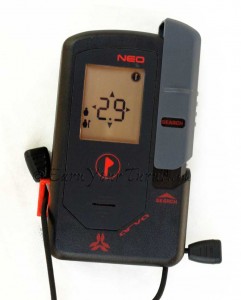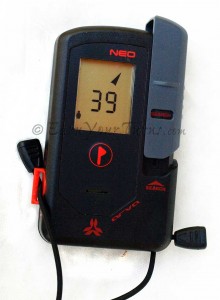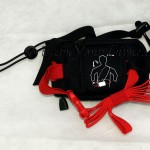Since then it seems Arva has always been playing a bit of catch up with technology. The same could be said of the NEO, but in this case, it doesn’t come up short, it is finally on par with everyone else, which is nothing to sneeze at. Based on my first run through of basic beacon tests the Neo performs very well, winning a few close comparisons, bowing on a few others.
Ease of Use
In the ergonomics department it hits line a drive deep into the heart of intuition. Well, except maybe for how you turn it on. If you’ve never used an F1 before the on switch might take a moment to figure out. For those who have, it will be like shaking hands with an old friend, except in this case you insert the plug and turn it counter-clockwise for “on.”
Where the intuitive feel of Neo becomes more obvious is switching it to receive. Simply lift the tab forming the upper right corner and it begins to listen in for nearby signals.
Range
For a single victim, the range is a solid 65 meters for a best-coupled signal that drops to the 40 meter range for worst coupled. 40 meters may sound weak, but for a worst-coupled condition it’s not, allowing you to have confidence in a search strip wider than 40 meters. Be not deceived, in a multiple victim scenario it would be unwise to assume that much range.

Neo shows how many victims are in range on the L, how far away in the center, and if you’re within ‘marking’ distance, that is indicated in the upper R corner.
Which is part of where the intuitive response of this beacon really shines. As mentioned above, with a single victim the range is pretty impressive, even for a worst coupled signal. With more than one, especially for more than two, it is common for digital beacons to get constipated brains, especially if one of the victims has a long, ragged pulse shape, like older analog beacons. They lose track of one, can’t mark another, unmark a found victim, or simply ask you to wait while they call HQ ‘cuz their processor is on overload.
So that was the exact scenario I set up to see how easily I could tie Neo’s brains in a knot. The easy victim was oriented for optimal range, co-polarized with Neo’s receiving antenna. Off to starboard was an F1, just to mess with the ability to distinguish signals. Near the F1 was a Pieps dangling vertically.
Neo recognized the first victim 58 meters out. It didn’t see a second victim until it was within 25 meters of it. It didn’t see all three until they were all within 14 meters. It kept its focus on the strongest signal until it had been marked.
Inside of 3.5 meters the display changes to a circle with four compass points around the distance number. The arrows on the perimeter indicate if you’re getting closer or further away, as do the numbers.
Marking
Marking is fast. Just touch the flag button once, pressing ’til it clicks, and that signal is ignored for the duration of the search. No need to hold it down until it updates the screen. It updates the screen immediately after you feel the click. You know you’re close enough to mark, and the signal distinguishable enough to reliably mark it, when a small circle appears in the upper R corner of the display.
From there Neo quickly told me what direction to go for the second strongest signal, which turned out to be the F1. No muss or fuss with this one either, marking it as soon as it was 2 meters away.
Response Time
The only hiccup occurred next. After marking victim #2 the readout said to go right. Considering the last victim was vertical, and there’s a 50/50 chance the direction is 180° out of whack, it pointed me away from victim #3. I obeyed as if I didn’t know, and the distance readings quickly indicated I was getting further way. A quick about face required two periods for the distance reading to stop going up but the direction arrow was spot on immediately. Not a bad recovery time actually as I have seen others take twice as long to make up their minds on which way to go. Only the Tracker2 can reverse direction and not take an extra period to correct an erroneous distance reading, but it doesn’t keep track of how many victims there are, let alone mark those found.
Overall the response time of Neo is fast — not quite real-time like Tracker 2, but noticeably faster than Barryvox’ Pulse or Tour and dramatically faster than Ortovox 3+, or Pieps Tour when in the final phase of the search.
Conclusion
Overall that was an impressive display of hide & seek prowess, especially without bothering to read a manual. After doing so, I’m glad I didn’t waste my time — the manual is a classic example of using an internet translator instead of an English editor who breathes for the final copy edit.
If you want more nerd features, look at Arva’s Link or Axis. If you want a simple avalanche beacon that won’t confuse you when you really need it, the Neo should be one of your top beacons under consideration along with the Barryvox Element, Pieps Tour, and BCA’s Tracker2. For speed and simplicity, Arva’s Neo is hard to beat.
Arva
Neo
MSRP: $359
Power: 3 AAA batteries



2 comments
1 ping
Craig, How did you measure your range. Is this moving from the “buried” transceiver out? Or moving in towards the “buried” transceiver from no signal? Had the beacon picked up that signal prior to the test and not reset? 65m is significantly longer than arva is even claiming. The poor coupling position is within reason. Just wondering. Does the device seem bulky? It appears to be larger than all other devices on the market.
Thanks,
RG
Good Q. There is a permanent range set up behind our house that extends into forest service land with no detectable electrical interference. I have stakes set up every 5 meters (16.25 ft) out to 60 meters. I estimate beyond that. I start my range tests by switching the test beacon to receive AT 60m while rotating it in 3D to see if it detects a signal. Most do not until I get closer. The Neo did. So I switched ‘er off and moved out to 70m before checking again. I also don’t rely on a single test, but do it half a dozen (or more) times to make sure I’m getting consistent results.
First test is always for best coupled position. Then I rotate the xmitting beacon 90 degrees, and then again, orient it vertically. That way I’m covering all primary positions.
Another point on the range. It is in a wooded area, which theoretically won’t affect a magnetic signal, but may. I believe it yields realistic results since a good portion of worthwhile ski terrain in N. America is below treeline.
re: bulkiness. Neo is about the same size as a Pieps DSP or DSP Tour, Ortovox’s 3+, or the Tracker 2. Mammut’s Pulse/Element is a bit narrower, same length. More or less.
[…] Posts Review: Arva Neo v1 Bouncing Avy Beacons Home on the Range: How this test was performed BackcountryTalk: Beacon BBQ […]